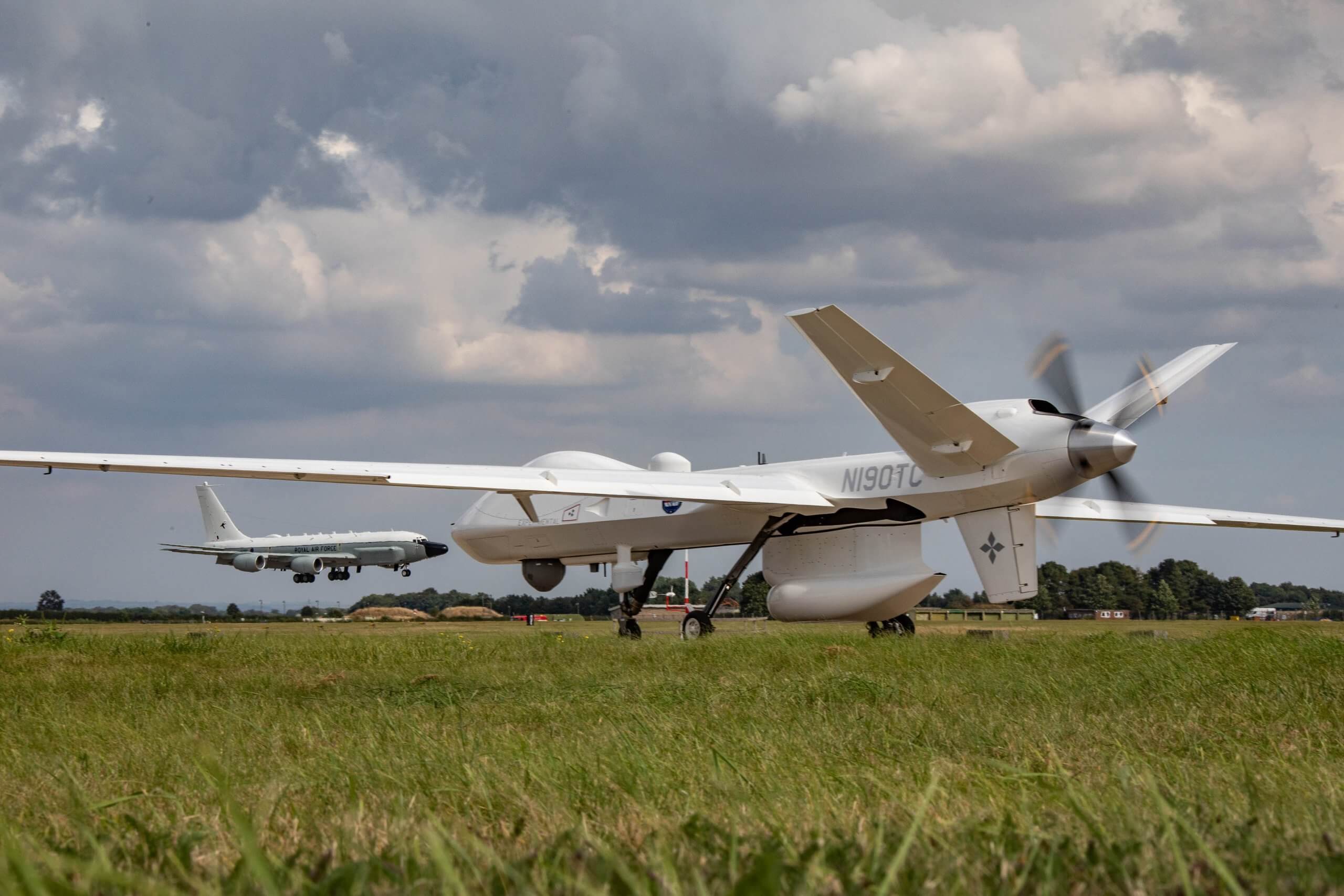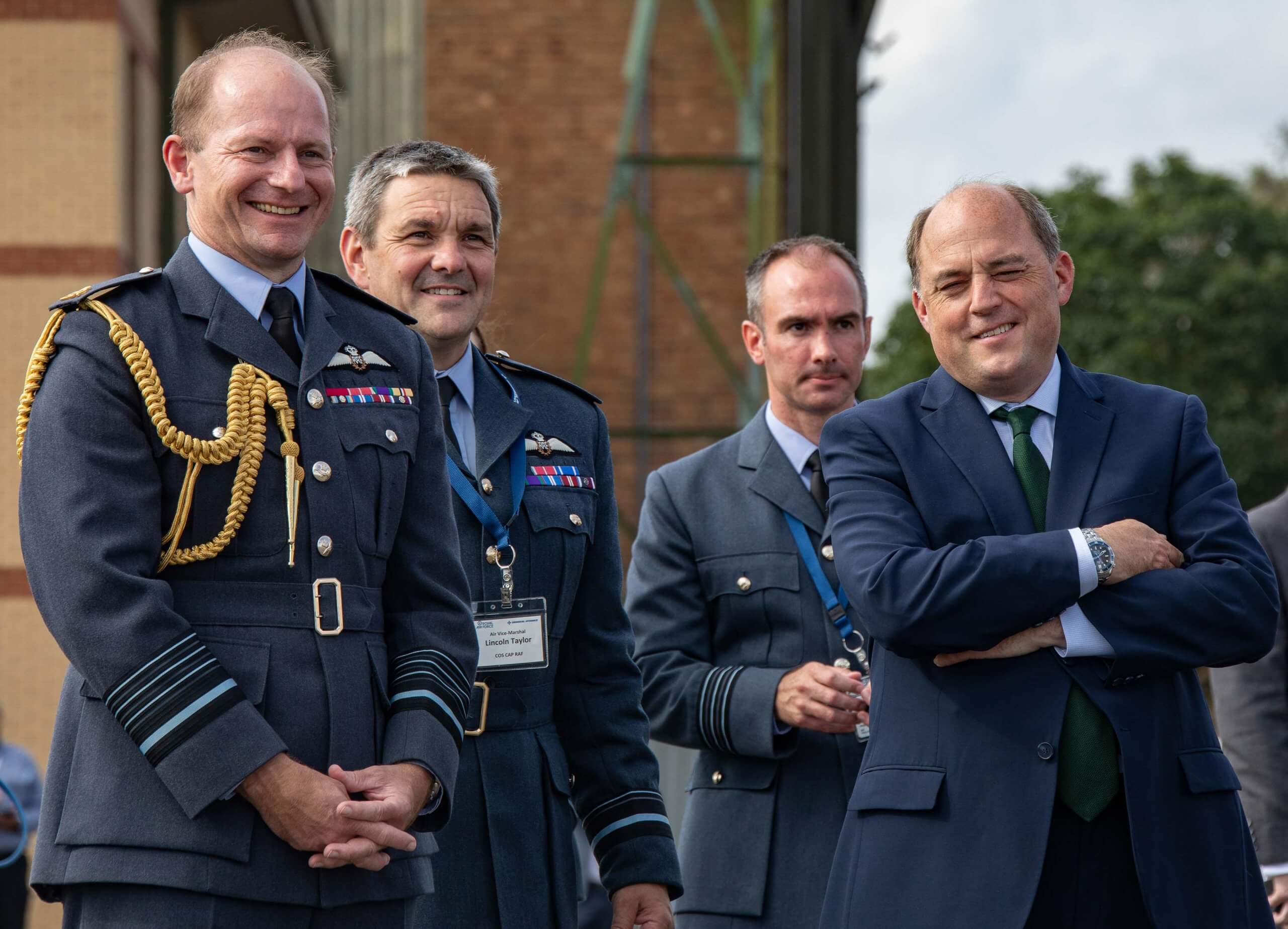
Air Chief Marshal Sir Michael Wigston, Britain’s Chief of the Air Staff, talked to Armada International about his hopes for the new Protector Remotely Piloted Air System (RPAS), soon to enter service with the Royal Air Force.
“As a military leader, I need to be ready to provide our decision makers with operational choice and ultimately, the ability to fight and win when deterrence and political discourse has run its course,” Sir Michael told Armada International, during a recent visit by the aircraft to the UK. “That requires a Royal Air Force (RAF) that is able and willing to pioneer advances in technology like Protector and to integrate it swiftly and seamlessly into our force.”
The General Atomics Aeronautical Systems (GA-ASI) Protector RG.Mk 1 is an advanced, medium altitude long endurance (MALE) RPAS developed from the MQ-9B SkyGuardian and being procured to replace the RAF’s Reaper RPAS. The 2015 Strategic Defence and Security Review (SDSR) set out an aspiration for the RAF to operate at least 20 Protector systems by 2025, replacing its current fleet of ten MQ-9A Reapers.
The new aircraft will bring enhanced armed Intelligence, Surveillance, Targeting and Reconnaissance (ISTAR) capability, including extended range, increased payload and planned integration of UK weapons.
During its recent deployment to the UK, the aircraft (actually the company-owned SkyGuardian prototype) initially operated from RAF Waddington in Lincolnshire. Waddington is the home of the RAF’s ISR/ISTAR force, including two Reaper RPAS squadrons. The aircraft was controlled from RAF Lossiemouth in Scotland, flown by GA-ASI pilots, and moved to the Scottish base on 12 September, to allow it to participate in Exercise Joint Warrior. The deployment allowed the RAF to refine the requirements that will be needed to fully integrate future Protector operations at RAF Waddington and Lossiemouth, and also allowed the type to undertake a series of capability demonstrations to partners and allies, including a two-day deployment to Royal Netherland’s Air Force (RNAF) base at Leeuwarden in the Netherlands.
Standing in front of the General Atomics SkyGuardian prototype at RAF Waddington, ACM Wigston, a former Panavia Tornado GR1 and GR4 pilot, was clearly in his element, barely able to contain his infectious enthusiasm for this exciting new capability for the air force he now leads.
“The Sky Guardian aircraft that you can see here is representative of the 16 Protectors that we’ve ordered and that will be based and operating from RAF Waddington from 2023. The enormous leap in technology that we will see with with Protector when it comes into service is something that I’m absolutely delighted to see. It’s another great technological step forward over its predecessor, the Reaper; Protector is a much more capable platform, both in terms of its aerodynamic performance, how long it can fly, how far it can go, but also in the range of different payloads and the different missions that it can fly,” stated Wigston.

“Protector can fly further for longer, it can fly for 40 hours, or with a full payload it can operate at over 1,000 miles away for nearly 20 hours. And it’s significant that we’re talking days rather than hours. So this is an aircraft that we can operate in large parts of the world That gives us enormous choice and gives our decision makers choices as to how the UK will operate and act on a world stage, at range and precisely,” he added.
The Protector will be integrated with next-generation UK weapons – the MBDA Brimstone missile and the Raytheon UK Paveway IV Laser Guided Bomb. There are seven weapons stations on the platform, allowing a total of 21 Brimstone missiles to be carried.
This means a significant uplift over Reaper, which could carry four Lockheed Martin AGM 114 Hellfire missiles and two 500-pound laser-guided bombs, though the RAF usually operated its Reapers with all four missiles, but only one bomb. The Protector’s armament will thus consist of precision strike weapons which significantly reduce collateral damage.
“It can also carry out a much wider range of potential missions – from flood monitoring to maritime patrol, to carrying weapons to conduct precision strikes on violent extremists who would do us harm, all the way through to some high end warfighting. It can assist in a climate emergency or humanitarian disaster, or it can do some of the more difficult counterterrorism missions in some fairly nasty parts of the world,” Wigston emphasised.
UAS Pedigree
The SkyGuardian on which the RAF Protector is based was originally developed as the certifiable Predator-B, and as such was designed to operate in civil airspace. It incorporates specific design changes to permit this, including ‘sense and avoid’ technology, lightning protection, and different composite materials which make for a more damage tolerant airframe.
“This programme was built with the intention that this aircraft would be able to operate in any airspace,” said Wigston. “Some of its predecessors … can only operate in operational areas – in war zones, whereas this aircraft has been built to the same standards, to the same levels of airworthiness, with the same sensors that you would put into an aircraft that carries humans. So right from the start UK Civil Aviation Authority (CAA) standards and international standards have been applied and that’s what gives this aeroplane so much utility compared to some of its predecessors. This has none of the restrictions that we have to work with when flying Reaper at the moment. Over the next few weeks we’ll be working with the CAA, civilian authorities, and allies to confirm our ability to operate this aircraft freely in UK and international airspace.”
Because Protector will, if requested, be able to operate in civilian airspace, it could be called upon to support civilian agencies in the search and rescue role, or for disaster response missions. It will also be better able to perform border patrol, fire detection and firefighting support, maritime patrol, and resource monitoring missions.
The Protector will be able to take off and land at a deployed take-off and landing point while being controlled via satellite from RAF Waddington, without the need for a ground control station at the deployed location. This is not possible with the current Reaper, and is a direct result of the level of automation incorporated in the newer aircraft. “The ability to fly itself, to take off and land itself, to ferry itself from one base to the next without humans operating it or actually doing the actual flying is a really significant element.”
When Armada International caught up with Wigston, the SkyGuardian was coming to the end of the Waddington phase of its deployment before flying to Lossiemouth to participate in exercise Joint Warrior, a multi-national large-scale military exercise.

The aircraft is currently in SeaGuardian configuration with a ventral multi-mode maritime surface-search radar with Inverse Synthetic Aperture Radar (ISAR) imaging mode, an Automatic Identification System (AIS) receiver, and Electronic Surveillance Measures (ESM) equipment along with the standard MTS-D High-Definition, Full-Motion Video sensor turret, which incorporates optical and infrared cameras.
Participation in Joint Warrior showcased how the MQ-9B’s maritime capabilities could be integrated with other air, surface and land platforms. We asked Wigston whether the deployment meant that the RAF was planning to acquire any Protectors in this configuration.
“A decision has not been made yet but it’s definitely one of the things that we’re exploring. This aircraft has undoubted utility to sit in the North Atlantic, to force multiply our [Boeing P-8] Poseidon force, thanks to its duration and the range of different payloads that it can carry. There’s no doubt in my mind that it has utility in in what we would describe as a maritime environment and so in a maritime patrol role.”
The UK’s first Protector RG.Mk1 (known as UK1, and actually the fourth MQ-9B SkyGuardian) successfully completed its first flight on 25 September 2020.
Following support system testing by a combined UK Ministry of Defence, US Air Force and GA-ASI test team, UK1 will be delivered to the UK Ministry of Defence in 2021, but will remain in the USA to complete the RAF’s test and evaluation programme. The first RAF crews will be trained in the USA in 2022.
The Protector RG.Mk1 is expected to achieve Initial Operational Capability (IOC) in 2024, with one 24/7 operational task line, and a UK-based training line. Full Operational Capability (FOC) will follow in 2026, with the ability to sustain three 24/7 operational task lines, and the UK-based training line.
The planned RAF Protector force will consist of two operational squadrons, with a total of 16 air vehicles, seven ground control stations, five synthetic training systems and some 501 personnel – aircrew, engineers, analysts and support trades.
Though the UK is the first customer for the MQ-9B, the new RPAS has also been selected by Belgium and by the Australian Defence Forces, and India will acquire the SeaGuardian variant. The UK and Belgium have already agreed to look at ways of working together and ACM Wigston, and his Belgian counterpart Major General Frederik Vansina, have signed a Bilateral Statement of Intent.

“This reflects our shared ambition for Protector, the MQ-9B Remotely Piloted Aircraft System, working in partnership to tackle threats to our national and collective security,” ACM Wigston said at the time. “The Royal Air Force and Belgian Air Force will explore opportunities to train, maintain and work together on this game changing aircraft using its cutting-edge sensors and systems to protect national, NATO and European security. The introduction of Protector MQ-9B reflects a step change in remotely piloted aircraft operations in Europe and worldwide. The Royal Air Force is delighted that the Belgian Air Force will stand beside us again on that historic journey.”
Wigston added that “the opportunities for future collaboration are vast,” and confirmed that RAF Waddington will host an international training facility on a new campus. This will enable crews from the RAF and international partners to conduct a significant amount of their training in a secure environment, and will be linked with the wider Defence Collective Training environment under the UK Gladiator programme.
According to ACM Wigston, the near £100 million investment in RAF Waddington’s state-of-the-art operating and training facilities for Protector represented “a clear demonstration of the UK government’s commitment to this exciting programme and our ambition to be the International Training Centre for some of the 30 allied Air Forces who have already expressed interest in Protector and the Sky Guardian. The International Training Centre will help us train alongside our partner air forces, starting with the Belgian Air Force, and provides us with this valuable opportunity to share our years of combat experience operating these remotely piloted air systems.”
“I’m also delighted that the Protector programme is investing substantially in UK industry,” Wigston added. “The collaboration between the Royal Air Force, General Atomics and 12 UK industry partners will see £400 million reinvested into the UK economy, with the potential to rise to £1 billion over the course of the programme. UK industry has contributed to every part of the aircraft system, from computer modules to the V tails, to engine development, weapons and logistical support.”
ACM Wigston is an extremely proud former commanding officer of the RAF’s No.12 Squadron, and when he wears a flying suit, reportedly always wears that unit’s badge – a fox’s head, with the motto ‘Leads the Field’.
We could not resist asking him whether, as a former No.12 Squadron CO, it gave him a particular thrill to think that the Royal Air Force that he commands now “leads the field” in such a vital and innovative capability area. “Thank you for that question,” he replied, with a grin: “I completely agree!”
by Jon Lake












